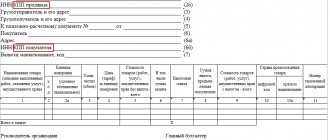What exactly is the problem and what risks does it pose?
More than 20 years ago, the Simplified Taxation System (STS) was introduced to stimulate small businesses.
In order to exclude the use of the simplified tax system by large and medium-sized companies, many restrictions were introduced into the Tax Code. Taxpayers often try to circumvent them using dubious schemes, which leads to additional assessments. One of the restrictions is that organizations that have branches do not have the right to apply the simplified taxation system (clause 1, clause 3, article 346.12 of the Tax Code of the Russian Federation).
Additional difficulties: if you are currently in a “simplified” state and you have so-called “separate divisions” (or what accountants consider to be separate divisions), then there is a risk... The risk that these divisions are recognized as branches, and as a result, You lose the right to apply the simplified taxation system.
In other words, they may recalculate all your taxes for the last three years, asking you to first pay VAT on all turnover for the last three years.
But let's not get ahead of ourselves. Let's consider all the nuances of this restriction.
How to switch to the simplified tax system if you have a branch
Organizations and individual entrepreneurs that plan to apply the simplified tax system starting from the next calendar year must notify the tax office about this no later than December 31 of the current calendar year.
If an organization has a branch, it must close it.
Termination by an organization of activities through a branch is reflected in the Unified State Register of Legal Entities.
Therefore, if at the time of filing an application to switch to the simplified tax system, a branch of the organization has already been excluded from the Unified State Register of Legal Entities, then it has no obstacles to apply this special tax regime starting next year, subject to other conditions provided for in Chapter 26.2 of the Tax Code (letter of the Ministry of Finance of Russia dated October 4, 2019 No. 03-11-11/76462).
The simplified tax system does not have the right to apply to organizations that have branches.
Federal Law No. 84-FZ of April 6, 2015 “On Amendments to Part Two of the Tax Code of the Russian Federation” introduced amendments to subparagraph 1 of paragraph 3 of Article 346.12 of the Code, according to which, from January 1, 2021, no one has the right to apply the simplified taxation system. organizations with branches.
According to subparagraph 1 of paragraph 3 of Article 346.12 of the Code (as amended before 01/01/2016), organizations with branches and (or) representative offices were not entitled to apply the simplified taxation system.
Thus, from January 1, 2021, organizations with representative offices and other separate divisions (not related to branches) still have the right to apply the simplified tax system. (this position is enshrined in the Letter of the Ministry of Finance dated March 6, 2017 No. 03-11-11/12586).
And here, given that our legislation (and especially tax legislation) does not always provide clear concepts and definitions of certain legal institutions and categories, we must be very careful and understand what a separate division is in general and how to correctly distinguish between such types of separate divisions as "branch" and "representative office".
The Tax Code does not contain the concepts of “branch”, “representative office”, “additional office” (or similar). Article 11 of the Tax Code of the Russian Federation provides only a definition of one general concept - “a separate division of an organization.”
Let us note that the application of the simplified tax system is not hampered by the presence of separate structural divisions in the organization that do not relate specifically to branches.
Profit share of a separate division
Payment of taxes and advance payments is made based on the share of profit. To calculate it, one of two indicators is taken as the basis:
- average number of employees of the EP (hereinafter referred to as SCOP);
- expenses for remuneration of employees of the OP (hereinafter referred to as OTOP).
The selected indicator, according to Article 288 of the Tax Code of the Russian Federation, is reflected in the accounting tax policy. The decision to make changes to tax policy is made from the beginning of the tax year. This is stated in Article 313 of the Tax Code of the Russian Federation.
The calculation of the profit share for the OP is carried out in accordance with a certain algorithm:
Calculation of the specific gravity of the selected indicator - SCHOP or OTOP Specific gravity SCHOP = SCHOP / SCHORG * 100%
or
Share of OTOP = OTOP / OTORG * 100%, where SCHORG and OTORG are indicators for the organization as a whole.
Calculation of the share of the residual value of the depreciable property of the OP (hereinafter referred to as OSOP)
Share of OSOP = OSOP / OSORG * 100%, where OSOP is the residual value of the organization’s depreciable property.
Calculation of the profit share of a separate division (hereinafter referred to as DPOP)
DPOP = (Share of SCOP + Share of OSOP) / 2
or
DPOP = (Share of OTOP + Share of OVOP) / 2.
How to calculate the share of profit for a separate division - it is advisable to give an example in the tax policy or in other documentation of the organization.
Note that when choosing an indicator of labor costs to calculate the share of profit, it is necessary to take into account the costs of wages for employees who are not part of the company’s staff and who work on the basis of civil contracts and contract agreements.
What is the difference between a separate division and a branch and representative office?
According to Art. 11 of the Tax Code of the Russian Federation, a separate division of an organization is any territorially separate division from it , at the location of which stationary workplaces are equipped. Recognition of a separate division of an organization as such is carried out regardless of whether its creation is reflected or not reflected in the constituent or other organizational and administrative documents of the organization, and on the powers vested in the specified division. In this case, a workplace is considered stationary if it is created for a period of more than one month.
And I immediately want to draw attention to the sign of territorial isolation... what do we mean by it?
As we understand it, territorial isolation is the location of a separate unit outside the location of the legal entity!
Definitions of branch and representative office (more specific categories) are given, in turn, in the Civil Code of the Russian Federation (Article 55).
And in these definitions, the legislator also refers to territorial isolation, using the phrase “outside the location.”
A representative office is a separate division of a legal entity located outside its location , which represents the interests of the legal entity and protects them.
A branch is a separate division of a legal entity located outside its location and performing all or part of its functions, including the functions of a representative office.
So, representation:
- located outside your location,
- only represents the interests of the organization and protects them.
The branch does a little more:
-also located outside your location,
- carries out all the functions of a legal entity or only part of its functions.
Consequently, under a “separate division” in the key that interests us (a division due to which the right to “simplified taxation” will not be lost) will be any other division that is neither a branch nor a representative office.
Based on this, let's look at a couple of examples:
- a pizzeria in another city a separate division or a branch? So, performs part of the organization's functions? Probably because it produces products.
- Represents the interests of the organization? Considering that the pizzeria sells product items, that is, enters into retail purchase and sale agreements, then yes, it represents the interests of the organization.
- Does it accept complaints about product quality? Quite possible.
- Based on this, the pizzeria may well be recognized as a full-fledged branch, and registering it as a “separate division” would be a risky step.
- The sales office is located in another city, then it already meets the criterion of territorial isolation (“outside the location”), which is also typical for branches and representative offices.
Current account of the company at the location of its OP
A company can open a bank account in any bank located near the actual location of its division, regardless of whether it has the status of a representative office or a branch. The Bank, in turn, cannot prevent this in any way, since in accordance with Art. 846 of the Civil Code of the Russian Federation, an organization has the right to enter into an agreement on opening and servicing an account in any bank branch on the terms proposed by it. In this case, the bank is obliged to meet her.
Refusal is permitted only in the following cases:
- the bank does not have the opportunity to conclude a banking service agreement or fulfill its provisions in full;
- based on the decision of the Tax Service, any movements in the company’s accounts must be suspended;
- the client organization refuses to provide all the necessary identification documents that the bank has the right to request in pursuance of the Anti-Money Laundering Law.
In Russia, banks open current accounts for various legal entities. persons in accordance with certain rules prescribed in the BR Instruction No. 28I dated September 14, 2006. But this document does not contain any restrictions regarding the number of accounts opened by one organization or the location of the bank in which these accounts are opened.
In order to conclude an agreement with the bank on opening and servicing a bank account, the company must provide the following package of documents:
- OGRULE;
- Constituent documents (Charter, decision on the appointment of a manager, etc.);
- Licenses confirming the organization’s right to engage in a particular activity (if required);
- A card containing sample signatures of the manager, chief accountant, other authorized persons, as well as a sample of the company’s seal;
- Documents indicating that the indicated company representatives actually have full right to dispose of the company’s financial assets, which are stored in a bank account;
- Documents confirming the rights of the sole director of the company;
- TIN.
From all that has been said, it follows that the company can freely open current accounts in any bank branches, including those located at the location of the OP. By drawing up a card containing sample signatures of persons authorized to carry out financial transactions on the company’s account, the legal entity. the person independently decides whether to grant such a right to the manager and chief accountant of the branch (division).
An important sign: what should we consider the location of a legal entity?
Here it is necessary to clearly distinguish between two basic concepts: the location of a legal entity and the legal address.
The location of a legal entity means the place of its state registration on the territory of the Russian Federation. In this case, it is not necessary to indicate a specific address as the location; the name of the locality (municipal entity) is sufficient. For example, you can indicate “Moscow city” or “Khimki urban district, Moscow region” as the location (clause 2 of Article 54 of the Civil Code of the Russian Federation).
The location of the organization must, firstly, be recorded in the constituent documents, and secondly, indicated when registering a legal entity for subsequent inclusion in the Unified State Register of Legal Entities (clause 5 of Article 54 of the Civil Code of the Russian Federation).
Often organizations are not located in one place, but have a wide network of branches and representative offices in different regions. In such cases, it is not entirely clear where exactly the organization should be registered. The answer to this question is contained in paragraph 2 of Art. 54 Civil Code of the Russian Federation. According to this norm, an organization must be registered at the location of its permanent executive body (general director, director or president). If there is no such body, the organization must be registered at the location of the body or person authorized to act on behalf of the organization by virtue of the law, other legal act or constituent documents.
Regarding the address of a legal entity. The address of a legal entity is the postal address where the permanent executive body of the legal entity is located. Like the location, the address (within the location) of the organization must be indicated during registration - this data is included in the Unified State Register of Legal Entities (clause 3 of Article 54 of the Civil Code of the Russian Federation).
Unlike the location, the address of a legal entity contains not only an indication of the locality (municipal entity), but also the street and house in which the organization is located.
The address of a legal entity does not need to be included in the constituent documents. For example, as follows from paragraph 2 of Art. 12 of the Federal Law of 02/08/1998 No. 14-FZ “On Limited Liability Companies”, the charter of the LLC must contain its location.
If the constituent documents already indicate the address of the organization corresponding to its location, there is no need to cross it out or change it.
Thus, when revealing the sign of territorial isolation , or the phrase “outside the location ” of a legal entity, it is necessary to understand that branches, representative offices and other separate units, in order to be recognized as such, must be located in another locality (municipal entity).
Notification of the Federal Tax Service on the opening of an OP
It is mandatory to notify the Federal Tax Service at the place of registration of the legal entity about each created OP. faces. This is necessary in order to register the unit with the Federal Tax Service office at its actual location.
To do this, a message informing about this fact must be sent to the tax office where the company is registered within a month from the date of opening of a separate division. No other documents are required to be provided. After receiving the notification, within 5 days the local Tax Service will itself register the above-mentioned division (Articles 83, 84 of the Tax Code of the Russian Federation).
A notification about the creation of a unit is provided to the Federal Tax Service in one of three possible ways: transmitted during a personal visit, sent to the inspection address by mail with notification, or via telecommunication channels (electronic version).
Failure to comply with the established deadline for filing a notification (a month from the date of opening of the unit) entails the application of punitive measures to the violating organization, namely, a fine in the amount of 10 thousand rubles. In addition to the Federal Tax Service, other funds must be notified about the creation of a separate division: the Social Insurance Fund, the Pension Fund of the Russian Federation at the place of registration of the company. The notification is drawn up in any form, and exactly one month is allotted for its submission.
Similar articles
- Order on the creation of a separate division
- 6 Personal income tax for separate divisions
- Registration of a separate subdivision 2021: step-by-step instructions
- How to create a separate division of an LLC?
- Order to close a separate division: sample
Other signs of branches and representative offices
Let us pay attention to other signs of branches and representative offices. After all, we now need to clearly distinguish between these concepts. If previously organizations on the simplified tax system were prohibited from opening branches and representative offices, now we are talking only about branches. And the courts themselves often confuse these concepts, revealing their characteristics. And very often, courts describe the characteristics of branches and representative offices together.
Here is a quote from the court decision: “To recognize the creation of a representative office or branch as such, a separate division must meet certain criteria and characteristics of a representative office and (or) branch: approval by the legal entity that created it of the regulations on the basis of which they act, endowment of property, appointment of the head of the representative office or branch , indication of a representative office or branch in the applicant’s constituent documents, while simultaneous compliance with all of the above conditions is mandatory. The absence of at least one of these signs means that a division of a legal entity cannot be recognized as a branch.”
(See Resolution of the Seventh Arbitration Court of Appeal dated December 2, 2014 in case No. A03-8507/2014).
Please note that first the court talks about the characteristics that characterize both the branch and the representative office, and at the end it refers to the fact that a separate division is recognized as a branch.
Of course, earlier (before 01/01/2016) it would have essentially made no difference whether a branch or representative office operated in the company (with any of these types of separate divisions, the company lost the right to use the simplified tax system). But from 01/01/2016 (when the creation of a representative office does not exclude the further use of the simplified tax system), I would like to see a clearer picture (the court’s distinction between the concepts of “branch” and “representative office”).
Judicial practice on this issue
Unfortunately, there is little judicial practice on this issue, and a number of cases that we found relate to the period 2010-2013, the so-called end of the “tax thaw” period.
When considering in court the issue of whether an organization has branches and representative offices, the courts will evaluate all the signs. The absence of at least one of them can be regarded as evidence that the structural unit is not a branch (representative office). Or it could be the other way around.
And vice versa, if we analyze judicial practice, we can see that despite the fact that the organization created separate divisions outside the location of the legal entity (they did not fall under the concept of a representative office or branch), since they did not represent the interests of the taxpayer; did not have an independent balance sheet or current account; were not indicated as a branch or representative office in the constituent documents. But they only carried out the sale of goods at retail.
Let's look at specific examples from judicial practice.
It is worth noting here that the above theses were selected from court decisions of 2010-2015. More relevant and as of 2016-2017. there are no solutions.
(Resolution of the Federal Antimonopoly Service of the West Siberian District dated May 23, 2013 in case No. a27-16427/2012; Resolution of the Arbitration Court of the Ural District dated December 29, 2014 No. F09-8604/14 in case No. A71-1573/2014;). The most revealing in judicial practice, where the court sided with the taxpayer, is the Determination of the Supreme Arbitration Court of the Russian Federation dated August 10, 2009 No. VAS-7488/09 on the refusal to transfer the case to the Presidium of the Supreme Arbitration Court of the Russian Federation.
First case:
Companies did not lose the right to use the simplified tax system, despite the creation of separate divisions, since the courts came to the conclusion that these divisions did not contain signs of branches and representative offices (judicial practice in favor of taxpayers).
It is worth noting here that the following theses were selected from court decisions for 2010-2015, when it was possible to “fly away” from the simplified tax system by using not only a branch, but also a representative office in your activities. More current solutions, and as of 2016-2017. (when the presence of separate divisions in the form of representative offices does not exclude the use of the simplified tax system) no.
(See: Resolution of the Federal Antimonopoly Service of the West Siberian District dated May 23, 2013 in case No. a27-16427/2012; Resolution of the Arbitration Court of the Ural District dated December 29, 2014 No. F09-8604/14 in case No. A71-1573/2014; ). The most revealing in judicial practice, where the court sided with the taxpayer, is the Determination of the Supreme Arbitration Court of the Russian Federation dated August 10, 2009 No. VAS-7488/09 on the refusal to transfer the case to the Presidium of the Supreme Arbitration Court of the Russian Federation.
Abstracts from court decisions:
The main position of the tax authorities and the reason for additional charges : According to the tax authority, outside the location of the company (in other regions), organizations create separate divisions that perform the functions of the parent organization and are branches, and therefore taxpayers are recognized as having lost the right to apply the simplified taxation system and are required to submit tax returns under the general taxation system.
Position of the arbitrators who supported the taxpayer and did not recognize him as having lost his right to the simplified tax system.
- The case materials do not contain evidence of the submission of relevant tax reports, the availability of data on the opening of current accounts for branches, the reflection of the activities of divisions in tax returns, the submission of information to the bodies of the Pension Fund of the Russian Federation, the Social Insurance Fund of the Russian Federation about branch employees, about the appointment of a branch director by the taxpayer and submission of a power of attorney confirming his authority.
- The tax authority’s conclusions about the presence of branches in the company were made by the tax authority only on the basis of a study of an extract from the Unified State Register of Legal Entities containing information about the presence of branches (the formal approach of the tax authority without checking actual business activities was noted).
- The created separate divisions are structural divisions of a legal entity that do not fall under the concept of “branch” or “representative office”, since they do not represent the interests of the taxpayer and protect them; engaged only in the retail sale of goods; do not have an independent balance sheet and current account, and their property and funds are taken into account in the general balance sheet of the legal entity; separate divisions are not indicated as branches and representative offices in the constituent documents of the taxpayer.
- Lack of evidence confirming the actual existence and functioning of the Company's separate divisions outside the location of the legal entity; in fact, plans to create representative offices were not implemented; during the period of activity of the structural divisions (less than a year), the Company did not fulfill any requirements of Article 55 of the Civil Code of the Russian Federation in terms of organizing the activities of the representative office, and also did not begin to register separate divisions.
- The inspectorate did not provide sufficient and reliable evidence of the actual activities of the representative offices outside the location of the legal entity; The tax authority did not provide in the case materials information about their location at these addresses, evidence of the creation and functioning of equipped stationary workplaces in representative offices for a period of at least a month, etc.
Second case:
The company was denied application of the simplified tax system.
Abstracts from court decisions: (see Resolution of the Arbitration Court of the Ural District dated March 16, 2016 No. F09-1692/16 in case No. A07-18712/2015).
Here the company went to court with a statement to declare illegal the tax inspectorate’s decision to refuse to satisfy the company’s application to switch to the simplified tax system.
The position of the arbitrators who supported the inspectorate’s decision to refuse the company’s application of the simplified taxation system.
- The case materials contain evidence of the creation and functioning of a branch of the company that meets the criteria listed in Art. 55 of the Civil Code of the Russian Federation (Charter of the Company; registration of the branch; reflection of information about the branch in the Unified State Register of Legal Entities; availability of the Regulations on the branch approved by the general meeting of participants; availability of primary documents confirming the financial and economic activities of the company’s branch).
- Availability of signatures of the acting director of the branch on primary documents.
- An application to apply the simplified tax system was submitted before the decision to close a branch of the company.
Conclusions on judicial practice: So, it should be noted that, being on a simplified taxation system, using a separate division in your activities (even if it is a representative office that has not been prohibited since January 2021), you need to be careful. Indeed, in the best case, you will simply have to appeal the decision of the tax authority to refuse to satisfy the application for the transition to the simplified tax system, and in the worst case, if the company is already working on the simplified tax system and the tax authority proves the fact of creating a separate division in the form of a branch, there is a risk of huge additional charges (VAT , income tax), because the entire income of the company will be recognized as income received under the general taxation system.
Declaration of tax paid under the simplified tax system.
We are considering a case where an organization using the simplified tax system has created a separate division. In this situation, she continues to use the “simplified approach” while fulfilling all the restrictions established by Chapter. 26.2 Tax Code of the Russian Federation.
Note that the simplified tax system is applied by the entire organization as a whole, including a separate division. Chapter 26.2 of the Tax Code of the Russian Federation does not contain requirements for separate accounting of goods sold, work performed or services provided in the parent organization and separate divisions.
Thus, an organization using the simplified taxation system keeps tax records of its activity indicators necessary to calculate the tax base and the amount of tax paid under the simplified taxation system for the organization as a whole, taking into account all income received and expenses incurred, regardless of where exactly these incomes were received and expenses were incurred: in the parent organization or a separate division.
In accordance with paragraph 6 of Art. 346.21 of the Tax Code of the Russian Federation, payment of tax and advance payments for tax under the simplified tax system is made at the location of the organization. When calculating the “simplified” tax, it does not matter in which city (region) of the Russian Federation the separate division was created.
Based on the results of the tax period, taxpayers submit a tax return to the tax authority at the location of the organization (Article 346.23 of the Tax Code of the Russian Federation).
Accordingly, at the location of the separate division, tax under the simplified tax system is not paid and a tax return is not submitted (letters from the Federal Tax Service for Moscow dated 08/31/2010 No. 16-15/ [email protected] , dated 06/22/2011 No. 16-15/ [email protected ] ).
Conclusions. What to do?
So, if a company still needs to use separate divisions in its activities:
- Taking advantage of the fact that from January 1, 2021, the Tax Code has established a restriction on the use of the simplified tax system by companies with branches, we recommend that you carefully distinguish between the concepts of a branch and a representative office, and use in your activities exactly this type of separate division as a representative office. The main danger here is that the tax authority does not detect signs of a branch in the activities of the representative office (clause 1, clause 3, article 346.12 of the Tax Code of the Russian Federation).
- You can, of course, continue to work on the simplified tax system, using a branch in your activities and fully complying with the criterion of entrepreneurial activity “at your own peril and risk”, wait whether your company will be checked or not noticed. But in our opinion, such risks are not justified.
- Instead of a branch, you can open another legal entity (which would duplicate the economic activities of an existing one). But there is a new tax risk here! Recognition of firms as interdependent (a sign of fictitious division of business in order to obtain unjustified tax benefits).
- A legal and absolutely non-risky way is to obviously, before opening a branch, switch to the general taxation system. This, of course, does not sound so attractive and profitable, but having a good understanding of tax legislation, you can choose benefits for a specific type of activity and profitably use the general taxation system, for example, with reduced tax rates (10% instead of 18%).







